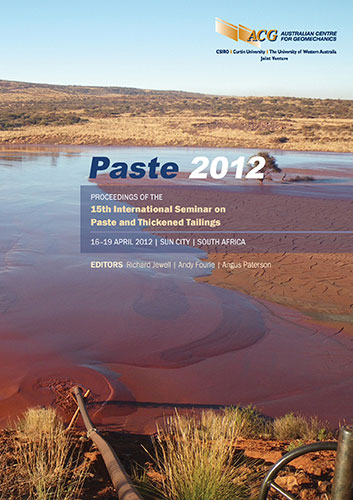Relating Atterberg limits to rheology

|
Authors: Fitton, TG; Seddon, KD |
DOI https://doi.org/10.36487/ACG_rep/1263_23_Fitton
Cite As:
Fitton, TG & Seddon, KD 2012, 'Relating Atterberg limits to rheology', in R Jewell, AB Fourie & A Paterson (eds), Paste 2012: Proceedings of the 15th International Seminar on Paste and Thickened Tailings, Australian Centre for Geomechanics, Perth, pp. 273-284, https://doi.org/10.36487/ACG_rep/1263_23_Fitton
Abstract:
The combination of rheology and soil mechanics is a relatively rare occurrence. Both fields are generally applied in quite separate circumstances, not usually at the same time. However, the transport and storage of thickened tailings slurries has created a situation in which both of these fields do come together. Whilst a thickened tailings slurry is flowing, it can be considered as a fluid. Rheometric equipment can be used to measure its flow properties, and rheological models and theories can be successfully applied to describe its behaviour. Once the tailings slurry is discharged into a storage facility, it typically flows across a ‘beach’ of previously deposited tailings, and eventually comes to rest. From this point onwards, the tailings particles are often considered as a soil, and the models and theories of soil mechanics then apply in describing the behaviour of the material. Tailings engineers often measure both the rheology and plasticity (by the use of the Atterberg limits test) of tailings materials in order to design for the transport and containment of the tailings, but sometimes samples are not available for testing, and documented lab test data for only one of these two aspects may exist. This paper presents new empirical relationships for the estimation of one from the other, based on a data set featuring 26 different tailings samples. Much of the observed variability in rheology can be accounted for by the plasticity of the material.
References:
AS 1289.3.1.1-2009 (2009) Methods of testing soils for engineering purposes – Soil classification tests – Determination of the liquid limit of a soil, Standard Australia.
AS 1289.3.2.1-2009 (2009) Methods of testing soils for engineering purposes – Soil classification tests – Determination of the plastic limit of a soil – Standard method, Standard Australia.
AS 1289.3.3.1-2009 (2009) Methods of testing soils for engineering purposes – Soil classification tests – Calculation of the plasticity index of a soil, Standard Australia.
AS 1289.3.3.2-2009 (2009) Methods of testing soils for engineering purposes – Soil classification tests – Calculation of the cone plasticity index of a soil, Standard Australia.
Atkinson, J.H. and Bransby, P.L. (1978) The mechanics of soils – An introduction to critical state soil mechanics, McGraw Hill Book Co., London.
Johnson, S.B., Franks, G.V., Scales, P.J., Boger, D.V. and Healy, T.W. (2000) Surface chemistry–rheology relationships in concentrated mineral suspensions, International Journal of Miners Processing, Vol. 58, pp. 267–304.
Pandian, N.S. and Nagaraj, T.S. (1990) Critical reappraisal of colloidal activity of clays, in Journal of Geotechnical Engineering, Vol. 116, No. 2, pp. 285–296.
Sofrá, F. and Boger, D.V. (2002) Environmental rheology for waste minimisation in the minerals industry, Chemical Engineering Journal, Vol. 86, pp. 319–330.
Stickel, J.J., Phillips, R.J. and Powell, R.L. (2006) A constitutive model for microstructure and total stress in particulate suspensions, in Journal of Rheology, Vol. 50, No. 4, pp. 379–413.
Zhou, Z., Scales, P.J. and Boger, D.V. (2001) Chemical and physical control of the rheology of concentrated metal oxide suspensions, Chemical Engineering Science, Vol. 56, No. 9, pp. 2901–2920.
© Copyright 2026, Australian Centre for Geomechanics (ACG), The University of Western Australia. All rights reserved.
View copyright/legal information
Please direct any queries or error reports to repository-acg@uwa.edu.au
View copyright/legal information
Please direct any queries or error reports to repository-acg@uwa.edu.au